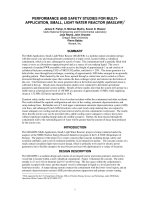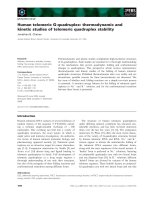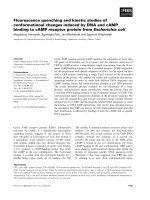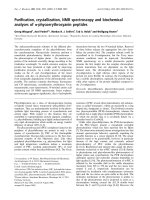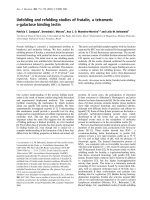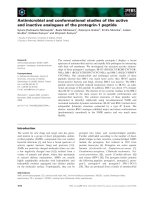Fourier transformed infrared absorption spectroscopy and kinetics studies of gas phase small molecules
Bạn đang xem bản rút gọn của tài liệu. Xem và tải ngay bản đầy đủ của tài liệu tại đây (1.67 MB, 152 trang )
FOURIER TRANSFORM INFRARED ABSORPTION
SPECTROSCOPY AND KINETICS STUDIES OF GAS
PHASE SMALL MOLECULES
LI SHUPING
(MSc.Chem, Xiamen Univ.)
A THESIS SUBMITTED
FOR THE DEGREE OF DOCTOR OF PHILOSOPHY
DEPARTMENT OF CHEMISTRY
NATIONAL UNIVERSITY OF SINGAPORE
2006
i
Acknowledgement
First of all I would like to take this opportunity to express my sincere and deep
appreciation towards my supervisor, Dr Fan Wai Yip who gave me the much-needed help,
advice and guidance. Thank you for your patience, effort as well as teaching me how to
use good English during the course of my PhD.
I am grateful to my group members; Li Peng, Tan Yen Ling, Jason Yang Jiexiang,
Tan Hua, Zhan Tong, Christian Lefföld, Lim Kok Peng, Lee Wei Te, Wong Lingkai, Toh
Ee Chyi, Ng Choon Hwee,Bernard, Tan Sze Tat, Tang Hui Boon. Thank you for your
help and support for these past few years.
I wish to thank Mr Conrado Wu of the Chemistry Department Glassblowing
workshop for fabricating all the glassware equipment for my experiments; Mr Tan Choon
Wah from Physics Department workshop and Mr Rajoo and Mr Guan from the
Chemistry Department workshop for their technical support.
I also appreciate the support from Mr Teo Leong Kai, Mr Sim Hang Whatt and
Mr Lee from the Chemistry Department Lab Supply room and Mdms Adeline Chia and
Patricia Tan from the Physical Chemistry laboratory.
Lastly I wish to acknowledge the National University of Singapore for offering
me the research scholarship and providing me the chance to pursue my degree here.
ii
Table of Contents
Acknowledgement i
Table of Contents ii
Summary v
CHAPTER 1 Introduction 1
1.1 Gas phase kinetics 2
1.2 Reactions of O(
3
P) atoms with CS
2
2
1.3 Photolysis of nitrite and atmospheric chemistry of alkoxy radicals 6
1.3.1 Photolysis of nitrite 6
1.3.2 Atmospheric chemistry of alkoxy radicals 9
1.4 Hydrogen atom abstraction reactions 15
1.4.1 General features of hydrogen abstractions 15
1.4.3 Abstraction reactions by t-butoxy radical 18
1.4.4 Reactions of Chlorine atoms (
2
P
3/2
) with hydrocarbons 21
1.5 Main Objectives 24
Reference 26
CHAPTER 2 O (
3
P) atom reactions with CSe
2
, SCSe and OCSe 32
2.1 Introduction 32
2.2 Experimental section 34
2.2.1 Synthesis of CSe
2
and SCSe 34
2.2.2 Experimental setup 35
2.3 Results 37
iii
2.3.1 Concentration Analysis 37
2.3.2 Reactions of O (
3
P) with CS
2
and OCS 40
2.3.3 Reactions of O (
3
P) atoms with CX
1
X
2
(X
1
=Se, X
2
=O, S or Se) 42
2.3.4 Reaction of CSe with O (
3
P) and O
2
51
2.4 Discussion 54
2.5 Computational studies 57
2.6 Summary 66
Reference 68
CHAPTER 3 Laser-induced decomposition of fluoronitrites 70
3.1 Introduction 70
3.2 Experimental section 72
3.2.1 Synthesis of nitrites 72
3.2.2 UV spectrum of CF
3
CH
2
ONO 73
3.2.3 FTIR setup 74
3.3 Photolysis of trifluoroethylnitrite 76
3.3.1 IR band of CF
3
CH
2
ONO 76
3.3.2 Photolysis of CF
3
CH
2
ONO 77
3.3.3 Effect of NO 82
3.3.4 Photolysis of CF
3
CD
2
ONO 83
3.3.5 Computational work 85
3.3.6 Reaction of CF
3
CH
2
ONO with O
2
87
3.4 Photolysis of other fluoronitrites 91
3.5 Conclusion 92
Reference 94
CHAPTER 4 Hydrogen atom abstraction kinetics by t-butoxy radical 96
iv
4.1 Introduction 96
4.2 Experimental section 97
4.3 Results and discussion 99
4.3.1 Concentration Analysis 99
4.3.2 Reaction of t-butoxy radical with hydrogen donors 100
4.3.3 Computational work 106
4.4 Conclusion 109
Reference 110
CHAPTER 5 Reaction of O (
3
P) and Cl (
2
P
3/2
) atoms with
CF
3
CHOHCF
3
and CF
3
CH
2
OH 112
5.1 Introduction 112
5.2 Experimental section 113
5.3 Computational studies 115
5.4 Results and discussion 115
5.4.1 Relative rate studies 115
5.4.2. Stable product analysis 122
5.5 Conclusion 133
Reference 143
v
Summary
The work in this thesis is directed towards understanding the kinetics of
elementary gas-phase reactions of small molecules using Fourier-Transformed Infrared
(FTIR) absorption techniques. The small molecules investigated here are deemed to be
important intermediates in atmospheric and combustion chemistry. Thus it is of relevance
to understand the kinetics and reaction mechanism involving these molecules.
The literature review of all the reactions investigated here is presented in Chapter 1.
In Chapter 2, the overall rate coefficients of the reactions of CSe
2
, SCSe and OCSe with
O(
3
P) atom have been determined to be k
CSe2
= (1.4 ± 0.2) × 10
-10
cm
3
molecule
-1
s
-1
,
k
SCSe
= (2.8± 0.3) × 10
-11
cm
3
molecule
-1
s
-1
and k
OCSe
= (2.4± 0.3) × 10
-11
cm
3
molecule
-1
s
-1
at 301-303K using Fourier-Transformed Infrared (FTIR) absorption spectroscopy. The
measurements have been accomplished by calibrating against the literature value of the
rate coefficient for O (
3
P) with CS
2
(4 x 10
-12
cm
3
molecule
-1
s
-1
). A product channel
giving OCSe in (32.0 ± 4.2)% yield has been found for the O + CSe
2
reaction. The
corresponding reaction for O + SCSe gives OCS and OCSe as observable products, with
their yields determined to be (32.2 ± 4.5) and (30.2 ± 3.3) %, respectively. Computational
studies using UB3LYP/aug-cc-PVTZ methods have been used particularly to determine
the reaction pathways, transition state, intermediate for the channels from which OCS or
OCSe is produced.
In Chapter 3, the unimolecular decomposition of alkoxy radicals, in particular the
trifluoroethoxy CF
3
CH
2
O radical, generated from 355 nm pulsed nanosecond laser
photolysis of its parent nitrite in the gas phase has been studied. The radical preferentially
vi
dissociates via its C-H bond cleavage to yield CF
3
CHO (trifluoroacetaldehyde) as the
major product. The infrared spectrum of formaldehyde, one of the products of C-C bond
dissociation of CF
3
CH
2
O was not observed under a range of nitrite and argon buffer gas
pressures. Similar results were obtained when thermal heating and broadband xenon lamp
irradiation of the nitrite were carried out. The addition of high pressures of NO further
decreased the production of CF
3
CHO since recombination of NO with the trifluoroethoxy
radical competes with the unimolecular dissociation process. Surprisingly, CF
3
CDO was
also the only product observed when the deuterated species CF
3
CD
2
ONO was photolysed
by the 355 nm laser. These observations contradicted MP2/aug-cc-pVTZ calculations
which were found to favour the C-C bond dissociation channel. However, 355 nm
photolysis of CF
3
CH
2
ONO in the presence of O
2
yielded trifluoroethylnitrate,
CF
3
CH
2
ONO
2
as the main product while CF
3
CHO and CF
2
O were also observable at
much lower yields.
In Chapter 4, the rate coefficients in the range of 10
-16
-10
-14
cm
3
molecule
-1
s
-1
have
been determined for the hydrogen atom abstraction reactions by t-butoxy radical of
several substrates in gas phase using FTIR Absorption Spectroscopy. The substrates
include halogenated organic compounds and amines. Arrhenius parameters for selected
reactions have been measured in the temperature range 299-318K. Transition states and
activation barriers for such reactions have been computed. The abstraction reaction is
believed to be elementary in nature.
In Chapter 5, the rate coefficients at 295±2K for the reactions of O(
3
P) atoms with
(CF
3
)
2
CHOH
and CF
3
CH
2
OH have been determined to be (5.6 ± 0.4) × 10
-14
and (6.6 ±
0.5) × 10
-14
cm
3
molecule
-1
s
-1
while the rate coefficients for the reactions of Cl(
2
P
3/2
) with
vii
the same fluoroalcohols, (CF
3
)
2
CHOH
and CF
3
CH
2
OH have been determined to be (4.9 ±
0.15) × 10
-13
and (7.5 ± 0.6) × 10
-13
cm
3
molecule
-1
s
-1
. Stable products formed during the
reactions have been detected by Fourier-Transform Infrared (FTIR) Absorption
Spectroscopy. The reaction of Cl(
2
P
3/2
) and CF
3
CH
2
OH has the most products; HCl,
CF
3
CClO, CF
3
CHO, HClCO, CCl
2
O and CO. We have also tentatively assigned some
new IR bands to an important chloroalcohol intermediate, CF
3
CCl
2
OH. Ab initio
calculations in Gaussian 03 have been extensively used to provide a better understanding
of the various reaction pathways leading to the generation of the stable products in the
Cl(
2
P
3/2
) and CF
3
CH
2
OH system.
Chapter 1 Introduction
1
– CHAPTER 1 –
Introduction
Chapter 1 Introduction
2
1.1 Gas phase kinetics
The study of elementary gas-phase reaction kinetics, a venerable area of chemical
investigation, continues to play a prominent role in our understanding of fundamental
chemistry and of large chemical systems [1-2]. High-precision laboratory measurements
of gas-phase radical reactions are responsible for much of the kinetic data especially on
combustion modeling [3] and atmospheric chemistry [4-5]. Optical inspection of change
in concentration of reactants and products following pulsed photolytic initiation has
become standard techniques in gas-phase radical reaction kinetics over the past several
decades. Due to the vast number of studies conducted, we can only focus on some of the
work which have been carried out for a few of these important gas phase kinetic systems.
In later chapters, we will extend the work on these particular areas using either flash laser
photolysis or broadband light irradiation for generation of the reactive species such as O
or Cl atoms. Fourier-Transform Infrared (FTIR) absorption spectroscopy is then used for
the detection and monitoring of the vibrational bands of both reactants and products.
1.2 Reactions of O(
3
P) atoms with CS
2
Reactions of oxygen atoms are very important in basic chemical kinetics and
dynamics and are of relevance in practical applications in atmospheric and combustion
chemistry [6]. In particular, the oxidation of naturally-occurring small sulfur-containing
compounds by oxygen atoms can produce SO radicals that lead to SO
2
and ultimately
yield acid rain in the atmosphere [7]. Oxygen atom reactions with sulfur compounds are
also crucial in the combustion chemistry of sulfur-containing fuels [8].
Chapter 1 Introduction
3
Carbon disulfide is one of the most common sulfur-containing species and the
reaction of oxygen (
3
P) atom with carbon disulfide, CS
2
has received considerable
attention for its role in atmospheric chemistry especially in the elucidation of global
sulfur cycle leading to acid rain [7, 9]. The reaction kinetics is also of primary interest in
the understanding of the CS
2
laser [10]. Three product channels have been observed for
this reaction [11];
O (
3
P) + CS
2
→ CS + SO (
3
Σ
-
) ∆
f
H° = -80.7 kJ mol
-1
1(a)
→ CO + S
2
(
3
Σ
-
g
) ∆
f
H° = -347.8 kJ mol
-1
1(b)
→ OCS + S (
3
P) ∆
f
H° = -227.4 kJ mol
-1
1(c)
There are several determinations of the total rate coefficient of this reaction at
298K using a variety of techniques. Hsu et al studied the reaction of O(
3
P) with CS
2
at
298 K by means of a CO laser resonance absorption technique [12]. Figure 1.1 shows the
total populations and rates determined for the two mixtures in which one of them
contained C
2
H
2
as reference. The measured ratio of the production rate of CO() from the
O(
3
P) with CS
2
versus the production rate of CO() from the O(
3
P) with C
2
H
2
reaction,
based on the extrapolation as shown in the upper part of Figure 4 is 0.373±0.048. The
rate constant for reaction 1(b) was detected to be (5.8± 0.5) × 10
-14
cm
3
molecule
-1
s
-1
and
(1.4 ± 0.2) % of O + CS
2
reaction preceded via this channel. Based on this value, the
overall rate constant of O + CS
2
was calculated to be (4.2 ±0.2) × 10
-12
cm
3
molecule
-1
s
-1
.
Gutman et al [13] studied the same reaction by employing molecular beams and
the overall rate constant was obtained from first order decay of CS
2
since the O atom
concentration was kept in large excess during the whole experiment. The average rate
Chapter 1 Introduction
4
constant was k= (4.0 ±0.3) × 10
-12
cm
3
molecule
-1
s
-1
at 302 ± 2 K. The branching ratio
for route 1(c) was determined using the expression: R
2
= k
2
/ k = [OCS]
t
/ [CS
2
]
t
with
the the linear relationship of [OCS]
t
vs [CS
2
]
t
shown in Figure 1.3. From the slope,
the branching ratio of 1(c) was determined to be 0.093 ± 0.008.
Figure 1.1 Absolute CO yields from the reaction of O(
3
P) atoms with CS
2
and C
2
H
2
under identical conditions
The initial evidence for channel 1(a) was the detection of CS and SO in a kinetic-
flash-spectroscopy study of O + CS
2
reaction [14]. The most direct evidence for the
existence of channel 1 was the detection of SO in a crossed-beam study of the reaction of
O + CS
2
[15] with indications that reaction 1 is the dominant pathway. Cheng et al. has
Chapter 1 Introduction
5
studied the dynamics of the dominant channel 1(a) by examining the vibrational state
distributions of CS (X
1
+
) and SO(X
3
-
) using laser-induced fluorescence spectroscopy
on the SO (B
3
-
- X
3
-
) and CS (A
1
- X
1
+
) (Figure 1.2)[16]. The resulting CS and SO
vibrational state distributions have revealed rather high vibrational temperatures of 1230
and 1312 K respectively
. Westenberg et al. used electron spin resonance (ESR)
spectroscopy to monitor the O(
3
P) decay rates in the presence of CS
2
at three different
temperatures [17]. They detected SO(X
-
) to confirm that the reaction did indeed take
place and further extracted an activation energy, E
a
= 0.25 kJ mol
-1
for the process. A
later study by Wei et al. is consistent with the first study, reporting an E
a
= 0.31 kJ mol
-1
for reaction 1(a) over the temperature range of 218-293 K [18].
Cooper et al. [11] used tunable infrared diode laser absorption spectroscopy
(TDLAS) to study the reaction of ground state oxygen atoms with CS
2
. The CO and OCS
products were probed under vibrationally-relaxed conditions for the precise
determination of their branching ratio. Results showed that the OCS + S channel
contributes 8.5 ± 1.0% to the total reaction rate, and CO + S
2
channel contributes
3.0±1.0%. The undetected CS + SO channel was then assumed to have contributed to the
balance.
Many other related studies have also been conducted such as the oxidation of CS
2
at high temperatures for the determination of the explosion limits of CS
2
/O
2
mixture,
reactive scattering using crossed molecular beams and chemiluminescence where the S
2
product of 1(b) was identified [19-22]. In addition, the kinetics of the reaction of carbon
monosulfide, CS with O(
3
P) atoms was also carried out [23] and the rate constant was
detected to be 2.06 × 10
-11
cm
3
molecule
-1
s
-1
.
Chapter 1 Introduction
6
Figure 1.2 Rotationally resolved LIF spectra of (a) SO (B
3
Σ
-
, υ’ = 1 – X
3
Σ
-
, υ " =3)
transition (b) CS (A
1
Π, υ' = 0 – X
1
Σ
+
, υ " =0) transition
1.3 Photolysis of nitrite and atmospheric chemistry of alkoxy radicals
1.3.1 Photolysis of nitrite
It has been known that photolysis of nitrite species results in the formation of OH
radical [24] and hence their uses as precursors of OH radicals in the studies of kinetics
and mechanisms of the reactions of OH radicals with organic compounds [25]. All the
alkyl nitrites show a similar UV absorption spectrum. In the range 300-400 nm, a well-
resolved vibrational progression is seen, corresponding to the A
1
A" X
1
A' (*n)
Chapter 1 Introduction
7
transition of N=O [26-27]. The UV absorption spectra of methyl nitrite and t-butyl nitrite
are shown in Figure 1.3 [27].
Figure 1.3 Electronic absorption spectra of (a) methyl and (b) t-butyl nitrite in the
gas phase at room temperature
In previous work, [28-29] the final products of photolysis of alkyl nitrites in gas
phase have been investigated. A general mechanism proposed for the primary process of
nitrite decomposition was that the HNO split off, usually together with either an aldehyde
or ketone. The H atom of NOH group can come from , or carbon atom of the nitrite.
For the detachment of hydrogen atom, the equation is represented by:
Chapter 1 Introduction
8
However Calvert and Pitts concluded that no unambiguous evidence was
available on this channel [30]. Later, considerable evidence proved that the primary
process for dissociation of nitrites in 300-400 nm is the homolytic cleavage of the RO-
NO bond yielding NO and alkoxy radicals [31-32]. So, it appears that nitrites could be
used as the precursor for alkoxy radicals and hence facilitating the studies on their
unimolecular decomposition and reactions with O
2
, NO and NO
2
for the last few years
[33]. More recent work is focused on the quantum-state resolved probing of the NO
photofragment by laser spectroscopy. The approach adopted most frequently in recent
studies of the dissociation dynamics of HONO and its alkyl derivatives is pulsed
photolysis and delayed probing of the nascent NO in its electronic ground state (X
2
Π
i
)
by laser-induced fluorescence (LIF) methods [34-35].
In the liquid phase, Townley et al have investigated the photolysis of primary,
secondary and aromatic alkyl nitrites. The corresponding hydroxynitroso dimers were
detected to be the products. The formation of the dimers was explained by the alkoxy
radical decomposition mechanism as well as the alkoxy radical rearrangement
mechanism [36-37].
C
O
N
O
H
H
R RCHO + HNO
h
Chapter 1 Introduction
9
1.3.2 Atmospheric chemistry of alkoxy radicals
Volatile organic compounds (VOCs) are emitted into the atmosphere from
anthropogenic and biogenic sources [38-39] and they may also be formed in situ in the
atmosphere as products of atmospheric transformations of other VOCs. The effects of
these VOCs on the environment have generated intensive scientific and public concern
due to possible harm on human, plant, and animal life. VOCs could undergo a number of
physical and chemical processes leading to their removal from the atmosphere [40-41].
The photochemical production of OH radicals in the troposphere leads to the
oxidative degradation of organic compounds emitted into atmosphere, thus limiting their
accumulation, which would lead to disruption of biogeochemical cycles and detrimental
effects on the environment. The initial attack of OH on the VOCs usually leads to the
formation of peroxy radicals, RO
2
. These radicals react with NO, other peroxy radicals or
via self-reactions to generate the corresponding alkoxy radicals. So it is not surprising to
find that alkoxy radicals are important intermediates in the chemical mechanism of
atmospheric oxidation of many classes of VOCs [42]. In addition, the conversion of NO
to NO
2
provides the net source of ozone as subsequent photolysis of NO
2
is followed by
the recombination of the O(
3
P) photoproduct with O
2
. The general oxidation scheme for
the VOCs is outlined in Figure 1.4 [43-44].
Chapter 1 Introduction
10
Figure 1.4 General hydrocarbon oxidation schemes
Once formed in the atmosphere, the alkoxy radicals can potentially undergo
three different competing reaction pathways [40-41]: (1) unimolecular decomposition,
which usually occurs through C-C bond fission to produce a carbonyl compound and
alkyl radical. The rate constant is denoted by k
d
. (2) Reaction with O
2
, which occurs via
-hydrogen abstraction to form a carbonyl compound and HO
2
radical. The rate constant
is donated by k
O2
. (3) Unimolecular isomerization [45-46] by intramolecular H atom
transfer (only effective for alkoxys which have four carbons) to generate a hydroxyl-
substituted alkoxy radical. The rate constant is donated by k
isom
. These competing
pathways are illustrated for 2-pentoxy radical in Figure 1.5.
RH
OH (hrs yrs.)
R
RO
2
ROOH RO
2
NO
2
RO
alkyl +carbonyl
carbonyl +HO
2
RH
O
2
(µs)
NO (sec min.)
O2
reaction
(µs-ms)
HO
2
(sec min.)
NO
2
(sec min.)
photolysis, OH
(days)
unimol.
dissociation
(µs-ms)
photolysis, OH
(days)
isomerization
(µs-ms)
Chapter 1 Introduction
11
Figure 1.5 Chemistry of the 2-pentoxy radical, illustrating potential reaction
pathways for a typical alkoxy radical [47]
It is the competition between the various potential alkoxy radical reaction
pathways that determines the distribution of the eventually oxidized stable products in a
particular oxidation scheme, and thus this in turn may influence the propensity of the
parent organic compounds to generate ozone. In general, unimolecular decomposition
k
d
k
isom
k
O2
Chapter 1 Introduction
12
leads to a more rapid breakdown of the carbon chain and generates more reactive short
chain carbonyl compounds which have a large potential for photochemical ozone
formation [44]. On the other hand, reaction with O
2
and unimolecular isomerization leads
to a preservation of the carbon chain with less reactive products and more highly
substituted oxygenated species, hence dampening the potential for local ozone generation.
Furthermore, the highly oxygenated species are more soluble and less volatile than short
chain species and thus they are more prone to participate in aerosol nucleation and
growth processes as well as aqueous-phase chemistry.
The importance of alkoxy radicals in the atmosphere has prompted the study of
their chemistry via a number of different approaches: (1) Pyrolysis or photolysis of static
gas mixtures and final-product analyses is used to determine relative rates for competing
alkoxy radical reactions which provide information on the relative importance of alkoxy
radical reaction pathways. (2) Time-resolved studies, using pulse laser-induced
fluorescence for direct detection of the alkoxy radicals themselves. (3) Theoretical
methods are now being applied to the determination of rate coefficients for unimolecular
reactions of alkoxy radicals.
In the 1970s, the reaction of various alkoxy radicals were investigated by
several groups to determined the unimolecular decomposition rates using relative rate
method [48-50]. Normally, the nitrite or peroxide was used as the precursor and the end
products were analyzed in the present of O
2
and NO
x
to obtain the rates. Relative rate
studies of alkoxy radical rate coefficients under conditions more relevant to the
atmosphere have generally been conducted using “smog” or “environmental” chamber
methodologies [51-53] and the final products are monitored via FTIR spectroscopy, GC
Chapter 1 Introduction
13
or GC/MS techniques, or chemical-ionization mass spectroscopy. The rate coefficients of
alkoxy radical reactions are shown in Table 1.1, 1.2 and 1.3.
Table 1.1 Alkoxy decomposition rate constant (Adopted from reference [54])
k
d
,
atm
/k
O2
(molecule cm
-3
)
T (K)
k
d,atm
(room temperature) (s
-1
)
2-butoxy
(2.6± 0.35) × 10
18
3.15 × 10
18
296
298
(3.9× 10
12
) exp(-47.1kJ mol
-1
/RT)
a
3-pentoxy
(3.6 ± 0.6) × 10
18
298
2.9× 10
4
1-propoxy
(3.8 ± 0.41) × 10
16
298
300
2-propoxy
(2.9 ± 0.3) × 10
16
298 230
The same value of k
O2
= 8×10
-15
cm
-3
molecule
-1
s
-1
is adopted for all alkoxy radicals to derive k
d,atm
from
relative measurements. a. Variable temperature experiments (280-313K) at 1 bar.
Table 1.2 Summary of the available data regarding the chemistry of halogenated
alkoxy radicals [44]
Radicals Dominant reaction pathway(s)
Products
Approximate rate (s
-1
)
CH
2
FO
reaction with O
2
HFCO + HO
2
N.A.
CH
2
ClO
reaction with O
2
HClCO + HO
2
N.A.
CH
2
BrO
unimolecular decomposition
CH
2
O + Br
>1 × 10
7
CHFClO unimolecular decomposition HCOF + Cl N.A.
CF
3
CH
2
O reaction with O
2
CF
3
CHO + HO
2
N.A.
CF
3
CF
2
O unimolecular decomposition CF
2
O + CF
3
5 × 10
6
CF
3
CFHO unimolecular decomposition
Reaction with O
2
CF
3
+CFHO
CF
3
CFO + HO
2
N.A
N. A
Chapter 1 Introduction
14
Table 1.3 Absolute rate constants for reactions of O
2
with alkoxy radicals [47]
RO
•
radical
10
15
× k(298K)
(cm
3
molecule
-1
s
-1
)
10
15
× A
(cm
3
molecule
-1
s
-1
)
Temperature
range (K)
Methoxy 1.9 7.2 298-610
Ethoxy 8.1 2.4 295-354
1-propoxy 11 2.4 223-381
2-propoxy 7.1 1.5 218-384
1-butoxy 14 ± 7 293
2-butoxy 6.5 ± 2
12 ± 4
7.7
0.133
0.12
293
223-311
221-266
3-pentoxy 7.2 ± 3.5
12 ± 6
0.41
293
220-285
Until recently, direct studies of alkoxy radical chemistry have predominantly
been carried out using pulsed laser-induced fluorescence [55-62]. This recent work has
led to an extension of the database of reactions of larger alkoxy radicals with O
2
and NO,
and more importantly is that it has led to the first direct determination of the dissociation
processes [52-55, 62]. In parallel to these LIF studies, Carr and co-workers [63-64] have
developed a flash photolysis/mass spectrometer system which they have applied to the
time-resolved study of halogenated alkoxy radical reactions.
Chapter 1 Introduction
15
1.4 Hydrogen atom abstraction reactions
1.4.1 General features of hydrogen abstractions
Ever since the early 1930s when chemists recognized the important role of free
radicals in many chemical processes, much effort has gone into measurements of the rates
of elementary steps involving atom and molecular radicals [65]. The reactions can be
classified as either unimolecular (decomposition or isomerization) or bimolecular ones.
The latter reactions have two possible pathways; firstly, there are addition processes
when the reactant is unsaturated since as alkenes and alkynes. Secondly, there are
homolytic cleavages of a single bond by radicals. An atom transfer occurs from the
reactant to the radical to form a new radical from the reactant. Normally, the atom most
commonly transferred is hydrogen as shown below;
R + H-X R-H + X (3)
Hydrogen atom abstraction reactions by organic radicals are ubiquitous in
organic chemistry [66]. The reactivities of differently bonded hydrogen atoms are
significantly different. The reactivity of reaction 3 is mainly determined by the difference
in the stability of the reactant (R) and product (X) radicals. If the stability of R is
decreased, while keeping the same H-X compound, the rate constant will be larger [67].
Keeping the R and changing the reactant in order to form a more stable product radical
will also give rise to a larger rate constant. Since the fundamental factor in determining
radical stability results from the delocalization of the lone electronic spin, it can be
expected that resonance factors will be of major importance for radical reactivity.
Chapter 1 Introduction
16
In some studies, the hydrogen abstraction reaction is applied as a standard
process in competition with other radical steps to be studied. The reactivity of the
compounds investigated is usually expressed by the rate constant ratio of the competing
reactions. The superiority of this method lies in the comparison of elementary steps of the
same kinetic order with respect to the radical.
A good way for exploiting the advantages of competing radical reactions of the
same kinetic order is offered by chain reactions. Although the concentration of the chain
carrier radicals is low, owing to their high reactivity and short lifetime, they can produce
easily-measured macroscopic changes in the amount of molecular reactants and products
of the chain process. Any species which is able to bring about reaction 3 with the chain
carrier radical and produces another radical of lower reactivity will affect the propagation
step, and hence reduces the rate of the chain process. This species will then be called an
inhibitor and the procedure to evaluate rate constants is known as the inhibition method.
In every radical process studied to date, the rates of hydrogen abstractions from
aliphatic hydrocarbons increase in the order of primary < secondary < tertiary structure
[68]. This order is independent of the nature of the attacking radical and is most easily
explained as due to the strengths of the C-H bonds being broken. Table 1.4 gives the data
for four radicals which follow the trend.
Chapter 1 Introduction
17
Table 1.4 Relativity of aliphatic hydrogens toward various radicals [68]
X
⋅ + RH HX + R⋅
Type of hydrogen
CH
3
⋅(455K) O⋅(333K) t-BuO⋅(313K) Cl⋅ (298K)
Primary 1 1 1 1
Secondary 7 9.3 8 3.6
Tertiary 50 44 44 4.2
Cyclohexane - 8.3 15 2.5
1.4.2 Abstraction of hydrogen by alkoxy radicals
Alkoxy radicals may be generated in a variety of ways, including the
decomposition of alkyl nitrites, alkyl peroxides and hypohalites. When alkoxy radicals
are formed in the presence of a hydrogen-containing substrate R’H, hydrogen atoms can
be abstracted from the substrate by the radical to yield an alcohol according to the
equation:
RO + R’H ROH + R’ (4)
For most alcohols, the bond dissociation energy D (RO-H) is approximately constant at
about 102 kcal mol
-1
for any given substrate molecule, reaction 4 will have roughly equal
exothermicity for many alkoxy radicals [69].
Most of the available information indicates that alkoxy radicals are appreciably
more reactive than alkyl radicals and the differences in reactivity arise from a lowered
energy of activation rather than from differences in pre-exponential factors. It appears
also that when various types of hydrogen atoms are present in a substrate, the order of
